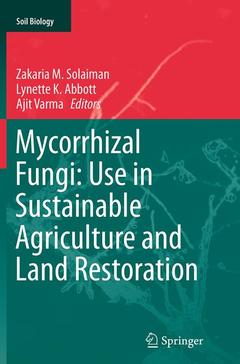Description
Mycorrhizal Fungi: Use in Sustainable Agriculture and Land Restoration, 2014
Soil Biology Series, Vol. 41
Coordinators: Solaiman Zakaria M., Abbott Lynette K., Varma Ajit
Language: English
Subjects for Mycorrhizal Fungi: Use in Sustainable Agriculture and...:
Publication date: 10-2016
Support: Print on demand
Publication date: 01-2015
407 p. · 15.5x23.5 cm · Hardback
Description
/li>Contents
/li>Comment
/li>
This volume explores the various functions and potential applications of mycorrhizas, including topics such as the dynamics of root colonization, soil carbon sequestration and the function of mycorrhizas in extreme environments. Some contributions focus on the use of arbuscular mycorrhizal fungi in various crop production processes, including soil management practices, their use as biofertilizers and in relation to medicinal plants. Other chapters elucidate the role of arbuscular mycorrhizal fungi in the alleviation of plant water stress and of heavy metal toxicity, in the remediation of saline soils, in mining-site rehabilitation and in the reforestation of degraded tropical forests. In addition to their impact in ecosystems, the economic benefits of applying arbuscular mycorrhizal fungi are discussed. A final chapter describes recent advances in the cultivation of edible mycorrhizal mushrooms.
This volume explores the various functions and potential applications of mycorrhizas, including topics such as the dynamics of root colonization, soil carbon sequestration and the function of mycorrhizas in extreme environments. Some contributions focus on the use of arbuscular mycorrhizal fungi in various crop production processes, including soil management practices, their use as biofertilizers and in relation to medicinal plants. Other chapters elucidate the role of arbuscular mycorrhizal fungi in the alleviation of plant water stress and of heavy metal toxicity, in the remediation of saline soils, in mining-site rehabilitation and in the reforestation of degraded tropical forests. In addition to their impact in ecosystems, the economic benefits of applying arbuscular mycorrhizal fungi are discussed. A final chapter describes recent advances in the cultivation of edible mycorrhizal mushrooms.




